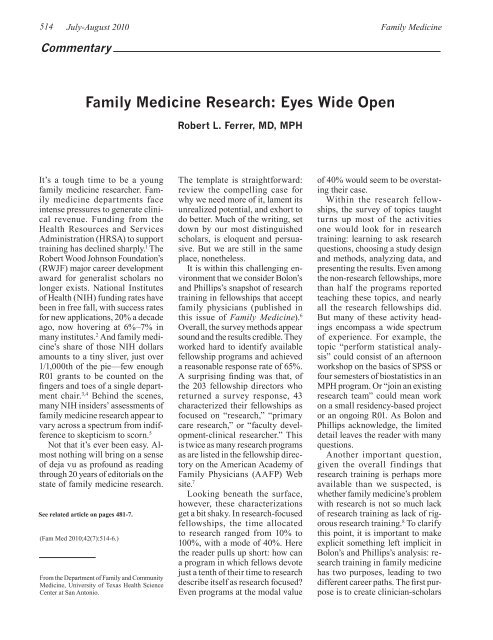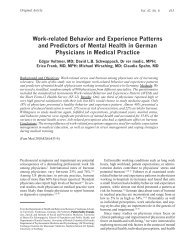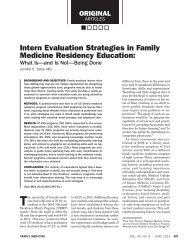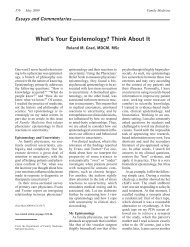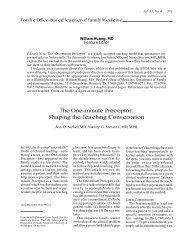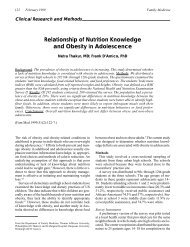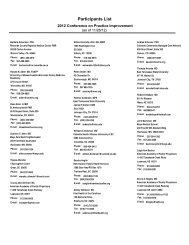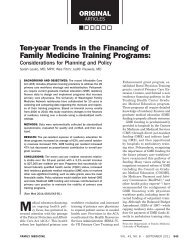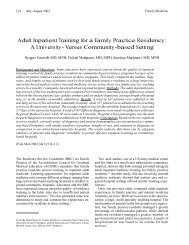Family Medicine Research: Eyes Wide Open - STFM
Family Medicine Research: Eyes Wide Open - STFM
Family Medicine Research: Eyes Wide Open - STFM
Create successful ePaper yourself
Turn your PDF publications into a flip-book with our unique Google optimized e-Paper software.
514 July-August 2010 <strong>Family</strong> <strong>Medicine</strong><br />
Commentary<br />
<strong>Family</strong> <strong>Medicine</strong> <strong>Research</strong>: <strong>Eyes</strong> <strong>Wide</strong> <strong>Open</strong><br />
Robert L. Ferrer, MD, MPH<br />
It’s a tough time to be a young<br />
family medicine researcher. <strong>Family</strong><br />
medicine departments face<br />
intense pressures to generate clinical<br />
revenue. Funding from the<br />
Health Resources and Services<br />
Administration (HRSA) to support<br />
training has declined sharply. 1 The<br />
Robert Wood Johnson Foundation’s<br />
(RWJF) major career development<br />
award for generalist scholars no<br />
longer exists. National Institutes<br />
of Health (NIH) funding rates have<br />
been in free fall, with success rates<br />
for new applications, 20% a decade<br />
ago, now hovering at 6%–7% in<br />
many institutes. 2 And family medicine’s<br />
share of those NIH dollars<br />
amounts to a tiny sliver, just over<br />
1/1,000th of the pie—few enough<br />
R01 grants to be counted on the<br />
fingers and toes of a single department<br />
chair. 3,4 Behind the scenes,<br />
many NIH insiders’ assessments of<br />
family medicine research appear to<br />
vary across a spectrum from indifference<br />
to skepticism to scorn. 5<br />
Not that it’s ever been easy. Almost<br />
nothing will bring on a sense<br />
of deja vu as profound as reading<br />
through 20 years of editorials on the<br />
state of family medicine research.<br />
See related article on pages 481-7.<br />
(Fam Med 2010;42(7):514-6.)<br />
From the Department of <strong>Family</strong> and Community<br />
<strong>Medicine</strong>, University of Texas Health Science<br />
Center at San Antonio.<br />
The template is straightforward:<br />
review the compelling case for<br />
why we need more of it, lament its<br />
unrealized potential, and exhort to<br />
do better. Much of the writing, set<br />
down by our most distinguished<br />
scholars, is eloquent and persuasive.<br />
But we are still in the same<br />
place, nonetheless.<br />
It is within this challenging environment<br />
that we consider Bolon’s<br />
and Phillips’s snapshot of research<br />
training in fellowships that accept<br />
family physicians (published in<br />
this issue of <strong>Family</strong> <strong>Medicine</strong>). 6<br />
Overall, the survey methods appear<br />
sound and the results credible. They<br />
worked hard to identify available<br />
fellowship programs and achieved<br />
a reasonable response rate of 65%.<br />
A surprising finding was that, of<br />
the 203 fellowship directors who<br />
returned a survey response, 43<br />
characterized their fellowships as<br />
focused on “research,” “primary<br />
care research,” or “faculty development-clinical<br />
researcher.” This<br />
is twice as many research programs<br />
as are listed in the fellowship directory<br />
on the American Academy of<br />
<strong>Family</strong> Physicians (AAFP) Web<br />
site. 7<br />
Looking beneath the surface,<br />
however, these characterizations<br />
get a bit shaky. In research-focused<br />
fellowships, the time allocated<br />
to research ranged from 10% to<br />
100%, with a mode of 40%. Here<br />
the reader pulls up short: how can<br />
a program in which fellows devote<br />
just a tenth of their time to research<br />
describe itself as research focused<br />
Even programs at the modal value<br />
of 40% would seem to be overstating<br />
their case.<br />
Within the research fellowships,<br />
the survey of topics taught<br />
turns up most of the activities<br />
one would look for in research<br />
training: learning to ask research<br />
questions, choosing a study design<br />
and methods, analyzing data, and<br />
presenting the results. Even among<br />
the non-research fellowships, more<br />
than half the programs reported<br />
teaching these topics, and nearly<br />
all the research fellowships did.<br />
But many of these activity headings<br />
encompass a wide spectrum<br />
of experience. For example, the<br />
topic “perform statistical analysis”<br />
could consist of an afternoon<br />
workshop on the basics of SPSS or<br />
four semesters of biostatistics in an<br />
MPH program. Or “join an existing<br />
research team” could mean work<br />
on a small residency-based project<br />
or an ongoing R01. As Bolon and<br />
Phillips acknowledge, the limited<br />
detail leaves the reader with many<br />
questions.<br />
Another important question,<br />
given the overall findings that<br />
research training is perhaps more<br />
available than we suspected, is<br />
whether family medicine’s problem<br />
with research is not so much lack<br />
of research training as lack of rigorous<br />
research training. 8 To clarify<br />
this point, it is important to make<br />
explicit something left implicit in<br />
Bolon’s and Phillips’s analysis: research<br />
training in family medicine<br />
has two purposes, leading to two<br />
different career paths. The first purpose<br />
is to create clinician-scholars
Commentary<br />
Vol. 42, No. 7<br />
515<br />
who are literate enough in research<br />
to teach how to critically evaluate<br />
papers, to supervise small research<br />
and quality improvement projects,<br />
and to participate in practicebased<br />
research networks (PBRNs).<br />
The second purpose is to create<br />
clinician-investigators who can successfully<br />
and sustainably compete<br />
for major research funding.<br />
Different Paths, Different<br />
Requirements<br />
Much of the prior editorialists’<br />
chagrin, as well as that of Bolon<br />
and Phillips in their discussion,<br />
focuses on the difficulty of achieving<br />
the second purpose—creating<br />
clinician-investigators who can<br />
obtain major research funding. The<br />
formula necessary to achieve it can<br />
be concisely summarized: there is<br />
no such thing as too much research<br />
training. Stated more formally,<br />
trainees need the following: (1)<br />
coursework in research methodology<br />
and statistical analysis, usually<br />
to the level of a master’s degree, (2)<br />
early and continuous involvement<br />
in an ongoing research program,<br />
with growing responsibility over<br />
time, (3) a meaningful relationship<br />
with an experienced mentor, preferably<br />
one with study section experience<br />
and success as an independent<br />
investigator, and (4) protected time,<br />
in excess of 50%.<br />
Even then, the journey is just<br />
beginning in what might be termed<br />
“investigator adolescence.” Training<br />
for clinician-investigators<br />
extends well beyond fellowship.<br />
Indeed, the average age for clinicians<br />
to obtain first-time R01 or<br />
equivalent awards is now nearly<br />
44. 8 Thus, a rigorous research fellowship<br />
should ideally lead to a<br />
rigorous career development award<br />
and then early investigator status<br />
with continuous mentoring and<br />
careful attention to assembling<br />
the team of talented investigators<br />
and staff that is necessary to be<br />
competitive.<br />
The lengthening path to becoming<br />
an independent investigator<br />
is well documented in successive<br />
surveys from the RWJF Clinical<br />
Scholars program. Even among<br />
this carefully chosen and welltrained<br />
group, the proportion who<br />
were disappointed with their career<br />
advancement rose rapidly from the<br />
1970s to the 1990s, nearly doubling<br />
from 20% to 39%. 10 An independent<br />
review of the scholars’ curricula<br />
vitae confirmed that the careers<br />
of later scholars progressed more<br />
slowly than those of their predecessors.<br />
9<br />
All of which is to say that we in<br />
family medicine have historically<br />
engaged in much wishful thinking<br />
about research careers. We have expected<br />
too much from lightweight<br />
research training. We have taken<br />
promising fellowship graduates,<br />
given them an office, and waited for<br />
R01s to emerge. We have expected<br />
big results in 3 years. We have not<br />
applied a sufficiently critical eye<br />
to young faculty’s progress with<br />
grantsmanship and collaborations.<br />
The Need for Clear-eyed<br />
Assessments<br />
It is time to be more honest with<br />
ourselves and our fellows about<br />
what can expected for a given investment<br />
in time and research training.<br />
The good news is that we’ve<br />
come a long way in understanding<br />
what it takes, 11 and pockets of success<br />
are beginning to emerge. 12 The<br />
bad news is that family medicine is<br />
woefully short of senior investigators,<br />
and it will likely take another<br />
generation of progress to grow our<br />
programs enough to support most<br />
of our new researchers with training<br />
grants and K-awards linked to<br />
senior investigator funding.<br />
There are emerging opportunities<br />
for such growth. Although it is<br />
too soon to know if the new Clinical<br />
and Translational Science Awards<br />
(CTSAs) can be leveraged broadly<br />
into research success, growing<br />
support for community engagement<br />
can only strengthen family<br />
medicine research in one of its core<br />
concerns. And the intense interest<br />
in improving the value of health<br />
care may generate additional funding<br />
for health services research.<br />
As we move forward, we need<br />
to frame the big questions about<br />
research training and then not flinch<br />
as we try to answer them. How<br />
many of the research fellowships<br />
identified by Bolon and Phillips<br />
have the capacity to successfully<br />
nurture clinician-investigators<br />
What is a realistic goal for how<br />
many “R” trajectory researchers<br />
we should be trying to graduate<br />
from fellowships each year What<br />
competencies necessary for success<br />
in emerging research areas<br />
are we failing to teach Who are<br />
our successful mentors How can<br />
we know when more investment<br />
in a person or program is unlikely<br />
to improve results And perhaps<br />
most important: are we preparing<br />
researchers to address the unmet<br />
needs of patients and communities<br />
Honest answers to these questions<br />
will help increase the odds that the<br />
experience of the next generation<br />
of family medicine researchers is<br />
better than the last.<br />
Correspondence: Address correspondence to<br />
Dr Ferrer, University of Texas Health Science<br />
Center at San Antonio, Department of <strong>Family</strong> and<br />
Community <strong>Medicine</strong>, 7703 Floyd Curl Drive,<br />
San Antonio, TX 78229-3900. 210-358-3930.<br />
Fax: 210-223-6940. FerrerR@uthscsa.edu.<br />
Re f e r e n c e s<br />
1. Harrison B, Bazemore AW, Dodoo MS,<br />
Teevan B, Wittenberg H, Phillips RL Jr.<br />
Title VII’s decline: shrinking investment in<br />
the primary care training pipeline. Am Fam<br />
Physician 2009;80:872.<br />
2. Mandel HG, Vesell ES. Declines in NIH<br />
R01 research grant funding. Science<br />
2008;322:189.<br />
3. Lucan SC, Phillips RL, Bazemore AW. Off<br />
the roadmap <strong>Family</strong> medicine’s grant funding<br />
and committee representation at NIH.<br />
Ann Fam Med 2008;6:534-42.<br />
4. Rabinowitz HK, Becker JA, Gregory ND,<br />
Wender RC. NIH funding in family medicine:<br />
an analysis of 2003 awards. Ann Fam<br />
Med 2006;4:437-42.<br />
5. Lucan SC, Barg FK, Bazemore AW, Phillips<br />
RL. <strong>Family</strong> medicine, the NIH, and the<br />
medical-research roadmap: perspectives<br />
from inside the NIH. Fam Med 2009;41:188-<br />
96.
516 July-August 2010 <strong>Family</strong> <strong>Medicine</strong><br />
6. Bolon SK, Phillips RL Jr. Building the<br />
research culture of family medicine with fellowship<br />
training. Fam Med 2010;42(7):481-<br />
7.<br />
7. American Academy of <strong>Family</strong> Physicians.<br />
Fellowship directory for family physicians.<br />
Available at www.aafp.org/fellowships/.<br />
Accessed February 12, 2010.<br />
8. Mainous AG, Hueston WJ. Is family medicine<br />
ready to move toward having professional<br />
researchers Fam Med 2006;38:<br />
361-2.<br />
9. Committee on Bridges to Independence, National<br />
<strong>Research</strong> Council, National Academy<br />
of Sciences. Bridges to independence: fostering<br />
the independence of new investigators<br />
in biomedical research. Washington, DC:<br />
National Academies Press, 2005.<br />
10. The Robert Wood Johnson Foundation. The<br />
Robert Wood Johnson Clinical Scholars Program.<br />
Available at www.rwjf.org/reports/<br />
npreports/scholarse.htm. Accessed February<br />
12, 2010.<br />
11. Jaen CR, Borkan J, Newton W, Association<br />
of Departments of <strong>Family</strong> <strong>Medicine</strong>. The<br />
next step in building family medicine<br />
research capacity: finding the way from fellowship.<br />
Ann Fam Med 2006;4:374-5.<br />
12. Cronholm PF, Straton JB, Bowman MA.<br />
Methodology and outcomes of a family<br />
medicine research fellowship. Acad Med<br />
2009;84:1111-7.


